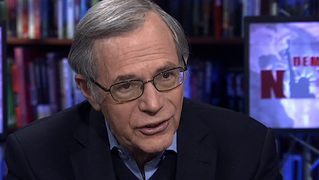
Guests
- Eric FonerPulitzer Prize-winning U.S. historian. He is DeWitt Clinton Professor of History at Columbia University and author of numerous books on American history, including, most recently, Gateway to Freedom: The Hidden History of the Underground Railroad.
As tens of thousands gather in Selma, Alabama, to mark the 50th anniversary of the historic voting rights marches of 1965, we go back 150 years to look at another chapter of the freedom struggle of African Americans. Between 1830 and 1860, more than 3,000 fugitive slaves reached freedom thanks to networks of anti-slavery resistance — commonly known as the underground railroad. Pulitzer Prize-winning historian and Columbia University professor Eric Foner is out with a new book, “Gateway to Freedom: The Hidden History of the Underground Railroad.” The book uses newly discovered, detailed records of slave escapes secretly kept by a leading abolitionist. In his “Record of Fugitives,” Sydney Howard Gay, the editor of the American Anti-Slavery Society’s newspaper, chronicled more than 200 escapes, some of whose stories Foner tells in this sweeping account, listing the identities of escaped slaves, where they came from, who their owners were, how they escaped and who helped them on their way to the North.
Click here to watch part 2 of this interview.
Transcript
JUAN GONZÁLEZ: Over the weekend, tens of thousands gathered in Selma, Alabama, to mark the 50th anniversary of Bloody Sunday, when police attacked a group of voting rights activists as they attempted to march to Montgomery. Well, today we go back 150 years to look at another chapter of the freedom struggle of African Americans. Between 1830 and 1860, more than 3,000 fugitive slaves reached freedom thanks to networks of anti-slavery resistance, commonly known as the underground railroad. The Pulitzer Prizer-winning historian Eric Foner is out with a new book, Gateway to Freedom: The Hidden History of the Underground Railroad. The book uses newly discovered, detailed records of slave escapes secretly kept by a leading abolitionist.
AMY GOODMAN: In his Record of Fugitives, Sydney Howard Gay, the editor of the American Anti-Slavery Society’s newspaper, chronicled more than 200 escapes, some of whose stories Eric Foner tells in this sweeping account, listing the identities of escaped slaves, where they came from, who their owners were, how they escaped, who helped them on their way north.
Well, for more, we’re joined by Eric Foner himself, professor at Columbia University, the author of numerous books on American history, most notably the award-winning work, Reconstruction: America’s Unfinished Revolution, 1863-1877 and The Fiery Trial: Abraham Lincoln and American Slavery.
Welcome to Democracy Now! It’s great to have you with us.
ERIC FONER: Nice to see you again, Amy. Yep.
AMY GOODMAN: What was the “gateway to freedom”?
ERIC FONER: Well, that’s sort of a term I use for New York City, because these networks, particularly on the eastern corridor here, of local groups assisting fugitive slaves, New York City was a key point there, because once slaves reached New York City, they were quickly sent up to New England or to upstate New York or Canada. So, really, this was the point from which they would be very close to freedom. I also use that title, although nobody realized it, in a slightly ironic sense, because that’s how we think of New York. You know, as a New Yorker, we think of ourselves—the Statue of Liberty is over here—as a place that people come seeking liberty, seeking better opportunity than they have somewhere else. But, in fact, here, you have the opposite. You have people having to flee New York, having to flee the United States, in order to achieve freedom. So, in a way, it’s a kind of—it’s a different kind of gateway than we normally think about. You have to leave to get freedom, not enter the United States.
JUAN GONZÁLEZ: And this Record of Fugitives that Sydney Howard Gay compiled, tell us the story of it.
ERIC FONER: Well, you know, this was pointed out to me by an undergraduate student a few years ago. I give her credit. She was doing her senior thesis about Gay’s journalistic career. And she said, “You know, Professor, the Gay papers are up in the Columbia Library, 80 boxes of them.” And she said, “You know, in box 72, there’s this document about fugitive slaves. It’s not really relevant for me, but you might find it interesting.” So I went up there one day. I said, “Give me box 72.”
And it’s really just two notebooks, and not that impressive-looking. But when I started looking through them, as you mentioned, they have these very detailed accounts about fugitive slaves. Gay’s a journalist. He interviews them. So you really get the stories of these people in their own words, which is quite unusual. Most of what we know about fugitive slaves is from reminiscences long after the event, and sometimes memory can play tricks on you. But here—and these are anonymous people; most of them just disappear from the historical record once they leave New York and get up to Syracuse and Canada. But I had never seen a document like this before. And I sort of started working outwards from it to try to track down who they were, who their owners were, who helped them. And eventually this book came out of that.
AMY GOODMAN: You mention the black hero. You tell the story of Louis Napoleon.
ERIC FONER: Yes. I had never heard of Louis Napoleon until I saw his name in the Record of Fugitives, which pops up all over the place in that document, because, you know, Gay’s office, this newspaper office, was also an outpost of the underground railroad. Napoleon was a free black man who worked as a kind of a janitor, a porter, in that building. But his real job was scouring the docks and the streets and the railroad terminals looking for fugitive slaves. He was the guy on the streets in the mid-1850s who would look for fugitives and bring them to Gay’s office. He was illiterate. There were documents in there signed by an X by him. But he was able to go to court and get writs of habeas corpus to—if someone was seized by slave catchers, he’d try to get them into court, you know, so maybe a judge could help them out. So, he’s a remarkable guy. And it’s just, you know, through this document, you get a bit of a sense of his activities. And Gay and Napoleon illustrate an important thing about the underground railroad. It was an interracial movement, black and white people working together in a common cause, which now, 150 years later, is kind of inspiring still.
JUAN GONZÁLEZ: You also devote a lot of time to another activist journalist of that era, David Ruggles and—
ERIC FONER: Yes.
JUAN GONZÁLEZ: The editor of the Mirror of Liberty, and you talk about his key role in terms of the underground railroad.
ERIC FONER: Well, Ruggles is a generation earlier. You might almost say that Ruggles is the founder of the underground railroad, because in 1835 he founded what was called the New York Vigilance Committee. Now, you know, fugitive slaves had escaped ever since there was slavery, but this is the first organized effort to help them. Otherwise—you know, previously, individuals had helped a fugitive slave, but there was no organization to do that. And the Vigilance Committee lasted all the way up to the Civil War in New York City. It’s sort of the second outpost. There’s Gay and his group, and then the Vigilance Committee. Ruggles left New York City in 1841, but he really was key in getting this whole process going.
And, by the way, his house is still standing, one of the few—you know, mostly we tear things down in New York, but Ruggles’ house on Lispenard Street is still there, from—
AMY GOODMAN: It’s an independent coffee shop in downtown Manhattan.
ERIC FONER: Yeah, yeah, and it has a little plaque, and it’s still there. And that’s where—you know, Frederick Douglass came to Ruggles’ house in 1838 when he got to New York from Maryland. So, Ruggles played a very important role in getting this whole process going.
AMY GOODMAN: In fact, didn’t Frederick Douglass—and his name didn’t start as Frederick Douglass—
ERIC FONER: Right.
AMY GOODMAN: —get married there?
ERIC FONER: Well, all these people changed their names. One of the things that’s interesting in the Gay thing is he’d give the name and then, in parenthesis, their new name, because, you know, to avoid capture, they changed their names. And, yeah, Ruggles told Douglass, “You’ve got to change your name to avoid capture.” And he did it twice. First he was Frederick Bailey, then he became Frederick Johnson. When he got to New Bedford, Mass., where Ruggles sent him, he said, “Hey, every other black family here is named Johnson, so I better find another name,” and then he decided to call himself Frederick Douglass. And that’s, of course, how we know him.
JUAN GONZÁLEZ: But Ruggles would actually confront slave catchers who were trying to grab people off the streets and send them back south, wouldn’t he?
ERIC FONER: Yeah. Ruggles was a very militant guy. He would go in—he went into a house in Brooklyn where—you know, there were many slave owners who came up to New York City with their slaves. You know, New York had very close economic ties to the South, the cotton trade, all that. And people would come, and even after slavery is abolished in New York state, there’s still slaves on the streets. Ruggles goes into someone’s house in Brooklyn and says, “These slaves are free. You don’t have a right to bring them into New York anymore.” And there’s a whole altercation. He does get one out to become free. He challenges ship captains. He goes to the docks. So he’s a very militant guy.
AMY GOODMAN: Professor Foner, tell us about Richard Riker and the Kidnapping Club.
ERIC FONER: Yeah, well, those who saw the movie 12 Years a Slave a couple years ago, you know, that’s about a free black man who was kidnapped, really, from upstate New York. There was a lot of kidnapping of free blacks in New York City and in Philadelphia, mostly children. There were these gangs that would just grab someone off the street, take him to a boat and ship him to the South for sale. Or they would take them to Richard Riker. He was a judicial officer called the recorder. And they would kidnap someone and say, “This guy’s a fugitive slave.” And they’d bring him to Riker, and Riker would just issue an order—”Yeah, he’s a fugitive slave. Back to the South”—even though the guy was born free. And this is why the Vigilance Committee was founded in the first place, to combat kidnapping. And it very quickly then turned into helping fugitive slaves. But, you know, New York was full of slave catchers. It was a dangerous place for fugitive slaves.
AMY GOODMAN: I want to turn to the film you just talked about—
ERIC FONER: Yeah.
AMY GOODMAN: —that won Best Picture, the Oscars—
ERIC FONER: Yeah.
AMY GOODMAN: —last year, 12 Years a Slave, directed by Steve McQueen—
ERIC FONER: Right.
AMY GOODMAN: —the other Steve McQueen.
ERIC FONER: Yes.
AMY GOODMAN: Or is the American Steve McQueen—
ERIC FONER: Yes.
AMY GOODMAN: —the other Steve McQueen? Whatever. This was the first time the top honor had gone to a black director. The film tells the story, as you said, of a free black man in New York who’s kidnapped, sent south, where he remains a slave for 12 years. This is from the film’s trailer.
SOLOMON NORTHUP: [played by Chiwetel Ejiofor] I was born a free man, lived with my family in New York—
Be good for your mother.
—until the day I was deceived—
UNIDENTIFIED: To Solomon.
SOLOMON NORTHUP: —kidnapped, sold into slavery.
UNIDENTIFIED: Well, boy, how you feel now?
SOLOMON NORTHUP: My name is Solomon Northup. I’m a free man. And you have no right whatsoever to detain me.
FREEMAN: [played by Paul Giamatti] You’re no free man. You’re nothing but a Georgia runaway.
EDWIN EPPS: [played by Michael Fassbender] And that servant that don’t obey his lord shall be beaten with many strikes. That’s scripture.
BASS: [played by Brad Pitt] The condition of your laborers, it’s all wrong.
EDWIN EPPS: They’re my property.
BASS: You say that with pride.
EDWIN EPPS: I say it as fact.
Speak! Man does how he pleases with his property.
You come here.
SOLOMON NORTHUP: Mr. Epps, I—
EDWIN EPPS: I said come here!
SOLOMON NORTHUP: Days ago, I was with my family, in my home. Now you tell me all is lost.
CLEMENS: [played by Chris Chalk] If you want to survive, do and say as little as possible.
SOLOMON NORTHUP: Well, I don’t want to survive. I want to live.
AMY GOODMAN: The astounding story of Solomon Northup in 12 Years a Slave. Eric Foner, this, again, as you said, New York state, though you focus on New York City. He was kidnapped from New York state.
ERIC FONER: Yeah, as I said, this was not uncommon, particularly in the 1820s and ’30s. By a little later, because of the Vigilance Committee, because the free black community became more and more mobilized against kidnapping, it tended to diminish by the 1840s and ’50s. But this was certainly a, you know, known process to black people in New York.
AMY GOODMAN: I wanted you to read from Gateway to Freedom, but first we’re going to break. Eric Foner is our guest, the Pulitzer Prize-winning author. His latest book is called Gateway to Freedom: The Hidden History of the Underground Railroad. Stay with us.
[break]
AMY GOODMAN: Our guest is Eric Foner, author of Gateway to Freedom: The Hidden History of the Underground Railroad. He is the DeWitt Clinton Professor of History at Columbia University, specializing in the Civil War. His book, The Fiery Trial, the book, The Fiery Trial, won the Pulitzer Prize. Can you tell us about one—read a section from your book.
ERIC FONER: Yes. Well, this about Henry Brown, who, as you’ll see in a minute, becomes known as Henry “Box” Brown.
“Equally dramatic was the tale of Henry 'Box' Brown, a skilled tobacco processor in Richmond whose wife and children, the property of a different owner, were suddenly sold to a Methodist minister in North Carolina … With his family gone, Brown devised a plan to have himself shipped north in a crate”—sort of like UPS, or whatever it was back then. “In March 1849, Samuel 'Red Boot' Smith, a Massachusetts-born white shoemaker, packed Brown into a rectangular box 'even too small for a coffin' (it measured only three feet long) and dispatched him by rail and steamboat to Philadelphia. … Upon Brown’s arrival, after a trip of more than 250 miles that took nearly twenty-four hours, [Miller] McKim [an abolitionist] tapped on the crate, asking, 'All right?' 'All right, sir,' came the reply. The lid was removed, and out stepped Brown, [quote] 'with a face radiant with joy.' 'Good morning, gentlemen,' he exclaimed, and launched into a 'hymn of praise.'”
And then Brown is quickly sent to New York, and then to Massachusetts. But, you know, you could not be safe in the North even after you escaped, because there were slave catchers around. So Brown eventually goes to England, where he spends the 1850s, and he becomes a sort of anti-slavery lecturer. But, of course, his exploit makes him a very celebrated figure.
JUAN GONZÁLEZ: Well, you argue in your book that the underground railroad was not merely a humanitarian enterprise, but it really was a key spark for what later became the Civil War.
ERIC FONER: Well, absolutely. I mean, the number of fugitives who escaped—there were four million slaves in 1860. So even though maybe a thousand a year escaped, from the whole South, I’m talking about, in the 30 years before the Civil War, that’s not destroying the system of slavery. But this issue of fugitive slaves became a major catalyst of the sectional conflict. Remember, it’s in the Constitution that Southerners have a right to get their fugitive slaves back. And then in 1850, the federal government passes this very severe law where federal troops, federal marshals, federal judges are, you know, invoked in order to get fugitive slaves back from the North. But this just leads to resistance in the North. And so, in the 1850s, the South is more and more alarmed about the growing number of fugitives and the growing efforts in the North really to violate—I mean, this is a good example of civil disobedience. There’s a long tradition of that in American history. What do you do when confronted with an unjust law? More and more people in the North are willing to violate the law to assist fugitive slaves on a humanitarian basis. But that then becomes a major political issue between North and South.
AMY GOODMAN: You know, we were just in Selma for the 50th anniversary of Bloody Sunday, and the next morning we went over to the First White House of the Confederacy—
ERIC FONER: Right.
AMY GOODMAN: —where Jefferson Davis lived. But in Selma, of course, we—what, upwards of 70,000 people marched over the Edmund Pettus Bridge.
ERIC FONER: Right.
AMY GOODMAN: Named for a Confederate general.
ERIC FONER: And a Klansman, right.
AMY GOODMAN: Former head of the—grand dragon of the Alabama Ku Klux Klan, and a U.S. senator. A man dressed as a Confederate soldier in Jefferson Davis’s house, who was taking people around, I asked him about the issue of slavery. He said, “Oh, oh, slavery was on its way out. That was not the issue here. It was all about states’ rights.”
ERIC FONER: Right, yeah. You know, the problem is that if you look at the Fugitive Slave Law, that was probably the most extreme example of federal—of the federal government intervening in the states and overriding state laws, local laws, local procedures. It invalidated all sorts of laws in the North, let’s say, trying to give a jury trial to an escaped slave—excuse me. And so, no, the South did not believe in states’ rights. It believed in slavery. States’ rights was a major defense of slavery, because—as a way of preventing Northern interference. But when it came to using the federal government to protect and defend slavery, they were perfectly happy to do that. No, and slavery was not dying out. It was definitely not dying out. Slavery was growing. It was expanding. It was wealthy. There was no peaceful scenario at hand in 1860, ’61, for the abolition of slavery.
JUAN GONZÁLEZ: And, of course, the enormous dependence of a lot of the industry and commerce of the North on slavery.
ERIC FONER: Well, New York City was a perfect example of that. You know, New York City was like a little microcosm of the national conflict. You had this underground railroad. You had a militant free black community. And yet, you also had merchants, bankers, insurance companies, ship builders, all of whose economic livelihood was tied into the South. So, New York had a very—they had the underground railroad; they also had a group of merchants, the Union Safety Committee, which was devoted to capturing and sending back fugitive slaves—both of them operating at the same time. So the city just exemplified this national division.
AMY GOODMAN: And explain why it was called the underground railroad?
ERIC FONER: Nobody knows exactly where that term originated. I guess “underground” suggests, you know, secret or private or something like that. Nobody knows where that term came from. But certainly by the 1840s, it was in very widespread use, just for people who were helping fugitive slaves. But we should not think of it like literally like a railroad. Sometimes people think, oh, there were these set routes and fixed stations. No, it wasn’t like that. It was much more haphazard. It was much more ad hoc. There were local groups in different places that communicated with each other, but it wasn’t a highly organized system.
AMY GOODMAN: Would you describe it as cells?
ERIC FONER: You might call it as cells, right, and they rose and fell over time. The Philadelphia Vigilance Committee went out of existence for several years because they just didn’t have any money. So, it wasn’t—you know, sometimes people think this is like a real railroad. But it was a lot more disorganized than that. But what’s amazing is that it did help many fugitive slaves get to freedom in the North and Canada.
JUAN GONZÁLEZ: And did you find much differences in terms of strategies and tactics among the organizers or the people who were involved in the movement?
ERIC FONER: Well, you know, the abolitionist movement, like, unfortunately, some other radical movements, was always fighting among itself. In 1840, it split into these two wings, the—it’s too complicated to go into—the Garrison wing and the Lewis Tappan wing. That’s why you had two outposts of the underground railroad in New York City. By the way, they were around the corner from each other, way downtown. They kind of were rivals, but they also cooperated sometime. But, yeah, there were differences in tactics. But, you know, even the people deeply involved in the underground railroad were also overground at the same time. They were publishing newspapers. They were holding conventions. They were, you know, sending petitions around. The people operated both legally and, you might say, sub rosa at the same time.
AMY GOODMAN: And this idea—and you referenced it earlier—that the underground railroad was whites helping blacks.
ERIC FONER: You get that in a lot of the early literature, particularly the reminiscences of white abolitionists well after the Civil War. You get this picture of, you know, courageous white people—which is true, they were courageous—sort of assisting helpless black people. That’s really not right. First of all, to escape from slavery was a courageous act, and it was very, very difficult to do. And the records of fugitives is full of these stories of people’s ingenuity and courage—and good luck, it took also to just get out, because a lot of people were captured who tried to escape.
AMY GOODMAN: And it wasn’t just running through the forest.
ERIC FONER: No. By the 1850s, they were on trains, they were on boats, they were in carriages. They’re using whatever method they can to get out. But it was—and then most of the people helping them in the North were free black people, free blacks in New York City, in Philadelphia. If you’re escaping in the South, you’re most likely to be helped by other slaves or free blacks, like in Maryland, where there quite a few of them. But there were plenty of white people, too. As I said, it was interracial. But it wasn’t just whites helping blacks. It was much more complicated than that.
AMY GOODMAN: And the role of Canada?
ERIC FONER: Well, you know, if you got to Canada, you were free. And Canada, to their credit, refused to extradite fugitive slaves. It was under the British then, of course, and, you know, the British Empire had abolished slavery in 1833. And the Canadians said, “Look, there’s no more slavery in the British Empire, so running away from slavery is not a crime on our books.” If you’re a murderer and you run away to Canada, they’ll extradite you to the United States, because murder is a crime in Canada. But they absolutely refused to send fugitive slaves back. And also in Canada, blacks could vote. They could serve on juries. They had better economic opportunities than they did even in the Northern United States. So Canada offered more to many black people than they could find in the U.S.
JUAN GONZÁLEZ: And you mentioned the involvement of free blacks in the movement. There was also a small but very vibrant black press at the time.
ERIC FONER: There was, yes.
JUAN GONZÁLEZ: Samuel Cornish, and Douglass, of course, himself, and Ruggles.
ERIC FONER: And New York—New York had the first black newspaper in the country, Freedom’s Journal, Colored American. Unfortunately for historians like me, they went out of existence as of 1841. And then you don’t—then you have about a 15-year period in New York with no black press, and then it comes back again in the later 1850s. So the information begins to become harder to come by in the mid-1840s and 1850s. So, you know, it’s like a little detective story here. You’ve got to pick up pieces from all over the place. But, you know, the information is there if you look hard enough.
AMY GOODMAN: In the last seconds we have with you, the 150th anniversary of the end of the Civil War is coming up.
ERIC FONER: In April, right. And then the 150th anniversary begins of Reconstruction. And as you said, I wrote a very long book on Reconstruction, and I do believe we need to think again about Reconstruction, because the issues of Reconstruction, of citizenship, of voting rights, of terrorism—like the Klan—are still facing our country today.
AMY GOODMAN: And that’s where we’re going to continue on part two of our conversation, and we’ll post it online at democracynow.org. Eric Foner has been our guest, author of Gateway to Freedom: The Hidden History of the Underground Railroad. He is the Pulitzer Prize-winning author, history professor, DeWitt Clinton Professor at Columbia University. He won the Pulitzer for The Fiery Trial: Abraham Lincoln and American Slavery and also wrote Reconstruction: America’s Unfinished Revolution, 1863-1877.












Media Options